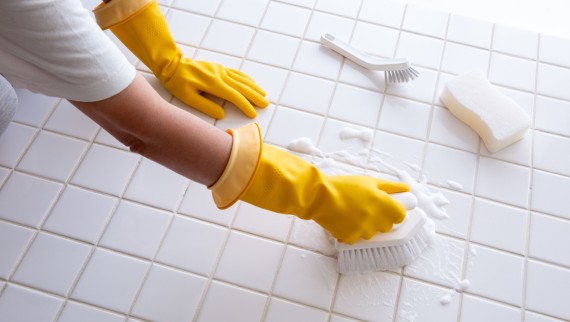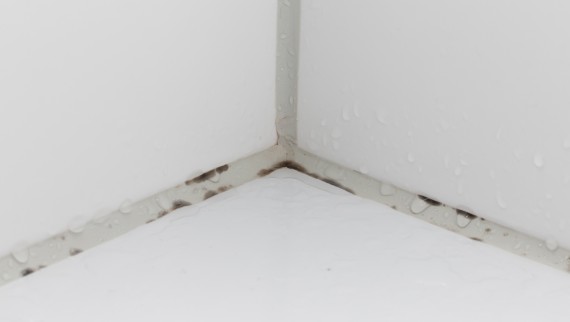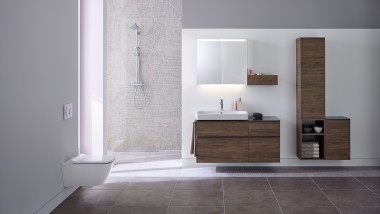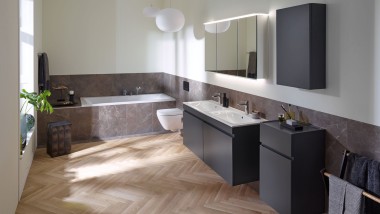Mould in the bathroom Causes, prevention and action
The bathroom is a place of refreshment, cleaning rituals and relaxation. Unfortunately, it can also be a breeding ground for mould. Mould is not only unsightly, it can also cause serious health problems such as allergic reactions and irritation to the skin, eyes and respiratory passages. In the latter case, this can develop into bronchitis and even asthma. For people with a weak immune system, mould spores are even more dangerous than for healthy people.
This guide contains information on how to remove mould in the bathroom easily or prevent it in the first place.
Why does mould build up in the bathroom?

Mould spores are found everywhere in the air. These are considered safe, as long as they don’t settle at a certain point and begin to spread. Various types of mould can be found in the bathroom. Black mould is the most stubborn and also the most harmful to health.
The bathroom is particularly susceptible to mould formation due to the high levels of humidity and often insufficient ventilation. Moisture – whether caused by showering, bathing or even drying clothes – provides ideal conditions for mould to grow.
Recognising mould in the bathroom
Mould build-up can be seen in the form of dark spots on walls, window frames, the ceiling or in silicone joints. A strong presence is often accompanied by a musty smell. Particularly at risk are the areas around the shower and bathtub.
Tips on preventing mould in the bathroom
Mould formation can be prevented effectively. The goal is to keep humidity levels in the room low. Fogged windows are a sign of excessive humidity, for example. Humidity can be minimised in the room through good ventilation, sealing off potential sources of moisture and the appropriate heating. The risk of mould can be reduced significantly by adhering to the following tips:
Tip 1: Correct ventilation
Ventilating the bathroom correctly allows the humidity in the room to be controlled and mould formation to be prevented. Here’s how:
- Quick ventilation: After bathing or showering, always open the windows fully for at least five minutes to let fresh air circulate.
- Tilt your windows: During the warmer months, the window can also be kept open slightly during the day.
In winter, the steam from the bathroom can be used to increase the humidity levels in apartments with very low humidity. To do this, simply leave the bathroom door open. In apartments with high levels of humidity, the bathroom door should be kept closed.
Tip 2: Sealing and insulation
If the outer walls of the building or windows are poorly insulated, water in the room condenses faster. This offers more favourable conditions for mould in the entire living space – especially the bathroom. Effective insulation can help to regulate the temperature and humidity in the room and thus reduce the build-up of mould.
Tip 3: Heating the bathroom
Warm air absorbs more moisture than cold air, meaning that less condensation forms on windows and doors in warm rooms. As a result, heated rooms are less susceptible to mould formation.
Additional tips for reducing humidity
After a shower or bath, remove any residual moisture with a wiper and always leave the door of a shower cubicle open. Ideally, a shower curtain should be spread out so that it dries faster.
Standing moisture in the bathroom can be prevented by:
- drying damp towels and bath mats immediately and not leaving them on the floor. A radiator for towels is a practical option for drying them faster while simultaneously heating the room.
- not hanging up wet clothes in the bathroom.
- setting up a dehumidifier that keeps the humidity levels at an optimal level.
Dealing with mould
Once mould has been detected in the bathroom, rapid action is recommended in order to stop it from spreading further. Choosing the right method depends on how significant the build-up is.
Surface mould and isolated mould build-up can be removed with commercially available cleaning agents. Wearing gloves, protective goggles and a mask prevents irritation to the skin, eyes and respiratory passages. Ventilate the room during cleaning. Tenants should inform their landlord immediately when mould occurs or there is a mouldy smell.

Tip 1: Cleaning agents against mould in the bathroom
On smooth surfaces in particular, mould can be removed thoroughly with water and commercially available cleaning agents. Apply the cleaning agent to the affected locations. Clean the area and then dry it thoroughly afterwards.
On rough surfaces, bleach can be added for disinfection. This contains chlorine and effectively eliminates mould spores. Make sure that bleach is not used together with acids, as this produces toxic chlorine gases. Ethyl alcohol with a 70 to 80% concentration has the same effect against mould spores.
It is recommended to always test cleaning products first on an inconspicuous area. In this way, you can ensure that no surface damage occurs.

Tip 2: Consult the professionals
If the mould has already penetrated deep into silicone joints or extensively across the masonry, then fast, appropriate action is needed to remove it. If mould appears repeatedly in the same place, then also consult a company that specialises in removing mould. In such cases, it is important that the cause of the mould build-up is found.
Following professional renovations, the application of special paint for rooms with high humidity can prevent mould from forming again.
Innovative solutions from Geberit for added hygiene in the bathroom
When choosing the bathroom equipment, ensure that it is moisture resistant or contributes to reducing moisture levels in the room. Floor-even shower surfaces from Geberit have no hard-to-reach places where mould can build up. After showering, the water can be removed quickly from the shower surface.
Bathroom furniture from Geberit is equipped with a moisture-resistant surface. The surface is usually made of melamine or foil that is additionally coated, depending on the colour. The material is very robust – and thus a good choice for the bathroom.
Common questions on dealing with mould in the bathroom
Does the selection of bathroom equipment have an impact on mould formation?
How can I tell whether my bathroom is ventilated sufficiently?
Newsletter Register now
Stay up to date
Our newsletter provides fascinating insights and handy tips on how your bathroom can make your life easier.















